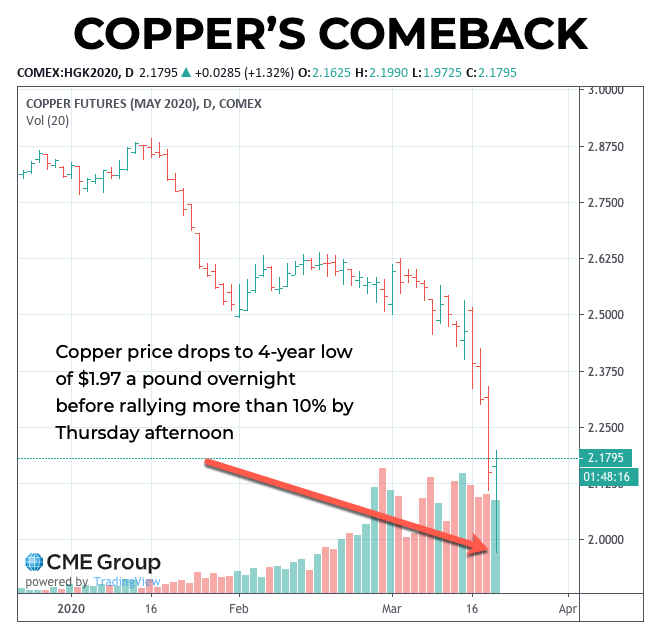Copper dropped sharply again in overnight trade on Thursday, coming close to levels last seen during the global financial crisis amid mounting uncertainty about the extent the global pandemic could hit demand and supply of the bellwether metal.
Copper trading in New York fell by more than 8% to $1.9725 a pound ($4,350 a tonne), the weakest level since early January 2016, when it traded below $2.00 for only a week. The last time it traded for a sustained period below this level was in 2008 and 2009.
In New York trade the metal fought back, rallying by 11.6% with May delivery contracts exchanging hands for $2.1990 in the mid-afternoon session. Year to date copper is still in bear territory with a 21% decline.

“In terms of understanding the short-term supply-demand dynamics, uncertainty is the highest I can recall,” Mark Hansen, chief executive officer of metals trading house Concord Resources, told Bloomberg from London.
“China responded more forcefully to the economic downturn in 2015-16 than it has now, which is both curious but also should give hope to resource demand possibly returning strongly, at some point.”
Global recession
Thanks to its widespread use in industry, transportation, construction and power grids, copper is vulnerable to slowdown in the broader economy.
A panel of 80 economists polled by FocusEconomics, a Barcelona-based research firm, have become markedly more pessimistic about the global impact of the pandemic.
Almost two-thirds of panelists now expect a global recession in the next 12 months, up from 43% in last week’s poll, and despite the slew of fiscal and monetary stimulus measures announced in recent days says FocusEconomics.
One panelist, Tommy Wu, lead economist at Oxford Economics, said the Covid-19 crisis is unlike any other modern-day economic shock:
“The fact that the coronavirus pandemic is an exogeneously caused simultaneous supply and demand shock on the real economy leading to financial market shocks, and not initially financial market shocks spreading into the economy like in 2008, makes it unique in recent history.
“It can only be compared to wartime downturns in the twentieth century.”
South American supply
Producers across South America, where the bulk of the world’s copper is produced, have halted or cut back operations and slowed construction projects.
Hong Kong-listed MMG said on Thursday that operations at its Las Bambas mine with expected production in the 360kt range for this year had been reduced temporarily after Peru declared a state of emergency.
Anglo American earlier this week said it will slow the building of its $5 billion Quellaveco project in Peru and on Thursday the miner said it is scaling down operations at its Los Bronces copper mine in Chile.
The world’s no 2 copper producer, Chile’s state-owned Codelco, said on Wednesday it planned to reduce its operations while the world’s top miner of the metal, BHP said so far the pandemic has not affected output.
Reuters reports unionized workers at the Escondida mine in Chile operated by BHP requested on Wednesday a halt to operations unless management begins to implement stricter health and safety measures. Escondida is the largest copper mine in the world by a wide measure and was projected to produce some 1.2 million tonnes this year.
Phoenix, Arizona-based Freeport-McMoRan said this week it is suspending operations at its 350kt per year Cerro Verde mine in Peru for at least 15 days.
Fonte: Mining.com





